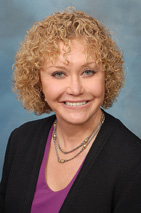
Untitled by Marguerite McDonald, MD

Marguerite McDonald, MD, has an impressive record of doing things first: she performed the world’s first laser vision correction procedure, the world’s first excimer laser treatment for hyperopia, the first wavefront-based laser surgeries in the United States, and the first epi-LASIK procedure in North America. She is also passionate about art, travel, and always looking ahead.
How do you choose which new technologies or techniques to pursue?
Three things are important in the assessment:
1. Is there enough evidence, even a reasonable theory, that this would be a significant breakthrough, that it would change the way we practice medicine?
2. Are there enough resources (National Institutes of Health grants, industrial grants, venture capital funding) to take this concept/product to the next level and eventual approval?
3. Does the company/research team have good management? Many a great pharmaceutical or device breakthrough has bitten the dust because of poor management.
As both an artist and a physician, how does each area inform the other in your life?
Artists are visionaries, and a good dose of “visionary” is useful in laboratory and clinical research. We all plod along, overwhelmed with obligations, our eyes on the rocky pavement beneath us as we inch forward one step at a time. Once in a while, it is interesting and important to take our gaze off the road beneath us, look at the horizon, and think, “What if?”
How has travel affected your view of the work you do at home?
Travel has had a profound impact on it. In regard to medical research and medical care, some countries and cultures do things better than we do, and some do them less well. It is instructive—and often humbling—to learn from others’ successes and to embrace opportunities for teaching around the globe. There are definitely lessons to be learned!
Of what personal or professional accomplishment are you most proud?
Beginning in 1985, I performed the first shaped ablations for refractive change in rabbits and primates, and on April 4, 1988, I performed the first PRK procedure in a human eye. That was actually in a fully sighted eye that was slated for exenteration.
Thousands of hours of work preceded this: shooting at innumerable plastic sheets, then cadaver eyes, then the eyes of living rabbits and monkeys. I was honored to influence the ultimate design of the laser to meet clinicians’ needs, to prove that corneas healed normally and that refractive change was predictable, and to establish the perioperative clinical protocols for anesthesia, suction, the ablation procedure, and postoperative care.
If you could not have been an ophthalmologist, what would you have most liked to do?
I loved being an actress in grade and high school. As a result of a statewide contest, I won a 4-year, all-expenses-paid scholarship to college if I would declare myself a theater major. I was very tempted to accept it, but my first choice was to be an MD. My parents generously agreed to let me pass on that amazing scholarship in order to pursue a biology/pre-med major.
I also love art. I actually had a double major in biology/pre-med and studio art. Making movies, painting, sketching, and sculpting were my major artistic interests. I decided that, if I did not get into medical school on the first try, I would apply to what is now the UCLA School of Theater, Film, and Television. I would have been very happy on either side of the camera.




